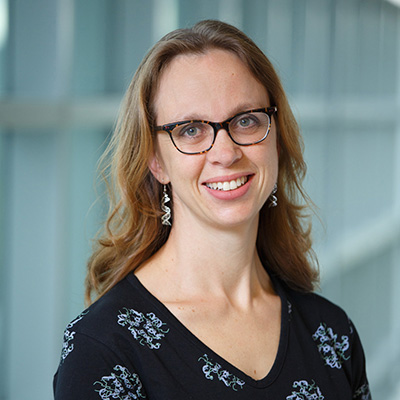Maria de Boef Miara
 Associate Professor in Biology
Associate Professor in Biology
My professional interests are the grownup version of a childhood spent catching frogs, collecting insects and trailing the vet on my family’s farm. As a comparative morphologist I explore the relationship between structure and function across species. The discipline of comparative morphology has its foundations in evolution, anatomy, physiology and ecology. My academic trajectory has allowed me to pursue my interests in the field, in the lab, and in classroom settings.
Research Background
I obtained my undergraduate and graduate degrees from McGill University in Montreal, Canada, under the guidance of Hans Larsson, a paleontologist and evolutionary developmental biologist. My time at McGill was split between the field and the lab. Palaeontological field work occurred in Alberta and on the islands of Nunavut, one of Canada’s northernmost territories, where we dug for ancient reptiles while fending off polar bears. In the lab, I studied the microstructure of bone fossils and extant species to learn which life events leave a measurable effect on the fossil record.
I completed my PhD while collaborating with Andrew Biewener at Harvard’s Concord Field Station unraveling the effects of exercise on bone. I continued at the Concord Field Station for my Postdoctoral work studying muscle physiology in mammals and birds. Combining ultrasound and x-ray imagery with measures of muscle length and force, this work lead to a new understanding of a decades old equation describing muscle action, paving the way for the next generation of muscle research.
Teaching
My passion has always been for teaching; I was a tutor by the third grade and never let up. My philosophy is to combine the best of new pedagological techniques with traditional lectures to present material both completely and engagingly. I always try to include opportunities for experiential learning through hands-on activities, projects or presentations into my classes. This allows students to work collaboratively; challenging each other and deepening their understanding.
The courses I regularly teach are:
- Cells and Organisms (BIOL15B): an introductory course in contemporary biology with an emphasis on cells, organs, and organ systems. This is an important prerequisite for many of the other courses I teach.
- Physiology (BIOL 42A): a course in which students learn the basic concepts that govern each organ and organ system and their integration to maintain homeostasis. We also explore how disruptions to this delicate balance causes illness.
- Advanced Cell Biology (BIOL 100B): explores how cells function independently and within their environments. The structure of organelles, their function, movement within and around cells, and how cells sense and react to their environment are examined.
- Evolutionary Developmental Biology (BIOL 112B): Covers evolutionary and developmental process and the critical influences and limits they have on each other. This begins at the genetic level, thinking about the role of gene duplication and homology in development and evolution, and is extended to the species level—thinking about what causes a dinosaur to evolve into a bird.
Other courses I have taught include Comparative Vertebrate Anatomy (BIOL 43B), The Biology of Human Sports and Exercise (BIOL 44A) and Stem Cells and Regenerative Medicine (BISC 8A).
Starting Summer 2015, I will be teaching the Justice Brandeis Semester (JBS) Program Bio-Inspired Design. During this 10-week session, a small group of students will experience a variety of settings — including laboratories, museums, zoos and the Brandeis MakerLab. They will collaborate with biologists, engineers and artists to explore intriguing life forms and develop the quantitative tools needed to work at the intersection of form and function. Students will design a nature-inspired product that solves an important societal problem. These designs will be presented to the Brandeis and local scientific communities in an interactive, TED-like forum.
Selected Publications
-
Lee SSM, Arnold AS, de Boef Miara M, Biewener AA, Wakeling JM. 2013. Accuracy of gastrocnemius muscles forces in walking and running goats predicted by one-element and two-element Hill-type models. Journal of Biomechanics 46(13): 2288-2295.
-
Lee SSM, de Boef Miara M, Arnold AS, Biewener AA, Wakeling, JM. 2013. Recruitment of faster motor units is associated with greater rates of fascicle strain and rapid changes in muscle force during locomotion. Journal of Experimental Biology216:198-207.
-
Padian K, de Boef Miara M, Larsson HCE, Wilson L and Bromage T. Research Applications and Integration. 2013. In Bone Histology of Fossil Tetrapods (ed Padian K ), University of California Press, Berkeley.
-
Wilson LE & de Boef Miara M. Database Standardization. 2013. In Bone Histology of Fossil Tetrapods (ed Padian K), University of California Press, Berkeley.
-
Wakeling JM, Lee SSM, Arnold AS, de Boef Miara M, Biewener AA. 2012. A muscle's force depends on the recruitment patterns of its fibres. Annals of Biomedical Engineering. 40(8):1708-1720.
-
Lee SSM, de Boef Miara M, Arnold AS, Biewener AA, Wakeling JM. 2011. EMG analysis tuned for determining the timing and level of activation in different motor units. Journal of Electromyography and Kinesiology. 21(4):557-565.
-
de Boef M. 2008. Signatures of Flight and Running in bone microstructure: An experimental study in helmeted Guineafowl (Numida meleagris) and applications in the study of the dinosaur-bird transition. Journal of Vertebrate Paleontology. 28 (3): 70A.
-
de Boef M, Larsson HCE & Horner J. 2007. Measurements of vasculature in Tyrannosaurus rex show a relationship between growth rate and vasculature orientation. Journal of Vertebrate Paleontology. 27 (3): 67A .
-
de Boef M & Larsson HCE. 2007. Bone microstructure: quantifying bone vascular orientation. Canadian Journal of Zoology. 85(1): 63-70.